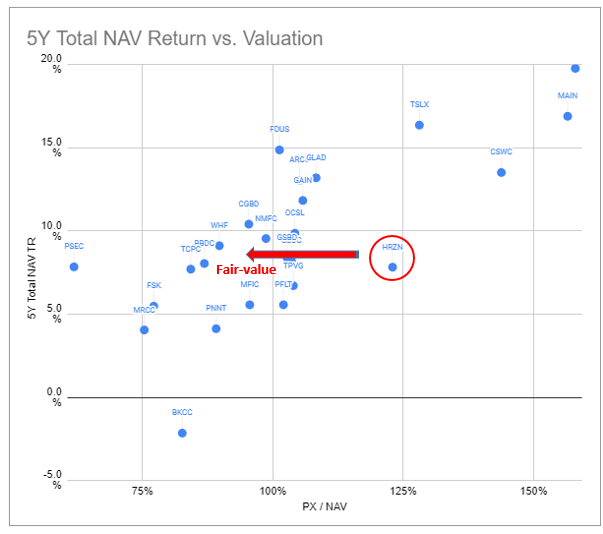HPE’s Challenges in FY24 Due to Slow Implementation of Server Infrastructure Purchased in FY23
March 18, 2024 | by stockcoin.net

Hewlett Packard Enterprise Company (HPE) finds itself facing challenges in FY24 as a result of the slow implementation of server infrastructure purchased in FY23, which has significantly impacted revenue growth. The bottlenecks caused by the high demand for Nvidia accelerators show no signs of resolution until late 2024. While HPE expects stronger margins from its as-a-service offerings and foresees substantial Annual Recurring Revenue (ARR) growth, server revenue is projected to decline. The unpreparedness of HPE’s customers for the new infrastructure acquired in FY23 has led to a sluggish pace of revenue growth. The combination of challenges in sourcing Nvidia GPUs and implementation preparedness has had a notable impact on HPE’s operations. Although the networking equipment market has been soft, there may be a shift towards AI-enabled and software-defined networking equipment. HPE forecasts significant ARR growth and margin expansion from its cloud-native offerings and AI applications. While HPE’s Intelligent Edge and Hybrid Cloud segments have had mixed performance, its Server segment has experienced a decline in revenue. Currently trading at a relatively high valuation, HPE’s shares may face a further pullback, potentially limiting share repurchases. As a result, a bearish trend may emerge for HPE’s share price, with a suggested price target of $14.38/share.

Challenges in FY24
Slow implementation of server infrastructure purchased in FY23
Hewlett Packard Enterprise Company (HPE) is facing challenges in FY24 due to the slow implementation of server infrastructure purchased in FY23. This delay in the implementation process has had a significant impact on the company’s revenue growth. The slow deployment of the server infrastructure has resulted in delays in providing services to customers and hindered the company’s ability to capitalize on market opportunities. HPE needs to address this issue promptly to ensure efficient utilization of the infrastructure and to meet customers’ demands.
Impact on revenue growth
The slow implementation of the server infrastructure purchased in FY23 has had a direct impact on HPE’s revenue growth. As the infrastructure is not fully operational, the company has been unable to generate expected revenues from its services. This has led to a decline in revenue growth compared to previous years. It is crucial for HPE to expedite the implementation process to mitigate further losses and regain its momentum in revenue generation.
Bottlenecks in Nvidia accelerators
Resolution expected in late 2024
Another challenge that HPE is facing in FY24 is the bottlenecks caused by the high demand for Nvidia accelerators. These accelerators play a critical role in enhancing the performance of HPE’s hardware and software solutions. However, the unprecedented demand has created supply chain issues, resulting in delays in acquiring sufficient Nvidia accelerators. As a result, HPE has been unable to meet the growing market demand, impacting customer satisfaction and potentially leading to missed revenue opportunities.
While this bottleneck issue persists, HPE is working diligently to address it. The company anticipates that the resolution of this supply chain challenge will occur in late 2024. By then, HPE aims to ensure a stable and consistent supply of Nvidia accelerators, allowing for uninterrupted service delivery and improved customer satisfaction.

Anticipated revenue
Stronger margins from as-a-service offerings
Despite the challenges faced in FY24, HPE anticipates stronger margins from its as-a-service offerings. The shift towards a subscription-based model allows HPE to generate recurring revenue and provides customers with more flexible and cost-effective solutions. The as-a-service model enables customers to access HPE’s products and services without significant upfront investments, thus increasing the overall value proposition for customers.
By leveraging this model, HPE expects to improve its profitability and achieve higher margins compared to traditional product-based revenue streams. This strategic shift will enhance HPE’s financial performance and mitigate some of the challenges faced in FY24.
Significant ARR growth
Additionally, HPE foresees significant Annual Recurring Revenue (ARR) growth in the coming year. The company’s focus on cloud-native offerings and artificial intelligence (AI) applications positions it well to capture the growing market demand for these solutions. Cloud-native offerings allow organizations to harness the power of the cloud for agile and scalable operations, and HPE is well-equipped to provide these services. With the integration of AI applications, HPE can further enhance its solutions and cater to the evolving needs of customers.
Both cloud-native offerings and AI applications have experienced substantial growth in recent years, and HPE’s emphasis on these areas presents an opportunity for significant revenue expansion. By capitalizing on this market trend, HPE expects to drive significant ARR growth and further solidify its position in the industry.
Expected decline in server revenue
While HPE anticipates stronger margins and significant ARR growth, there is an expected decline in server revenue. This decline can primarily be attributed to the slow implementation of server infrastructure purchased in FY23, as mentioned earlier. Until the infrastructure is fully operational, HPE may continue to experience lower server revenue. It is crucial for the company to accelerate the implementation process and address infrastructure challenges to mitigate the decline in this revenue segment.
Customer preparedness
Customers not prepared for new infrastructure
One of the challenges HPE has faced in FY24 is the lack of customer preparedness for the new infrastructure purchased in FY23. This lack of preparedness has resulted in slower revenue growth for the company. HPE’s customers may not have anticipated the timing or magnitude of the infrastructure upgrade, leading to inadequate readiness to integrate and leverage the new solutions effectively.
To address this challenge, HPE needs to ensure effective communication and collaboration with its customers. Providing comprehensive training and support can assist customers in navigating the transition and leveraging the new infrastructure for improved business outcomes.
Slower revenue growth
As a result of the customers’ lack of preparedness for the new infrastructure, HPE has experienced slower revenue growth. The company’s ability to generate expected revenues from its services has been hampered due to the delayed adoption and utilization of the purchased infrastructure. This slower revenue growth puts additional pressure on HPE to expedite implementation and support its customers effectively. By addressing customers’ preparedness and providing necessary assistance, HPE can overcome this challenge and achieve accelerated revenue growth.

Sourcing challenges
Difficulty in sourcing Nvidia GPUs
In addition to the bottlenecks in Nvidia accelerators mentioned earlier, HPE is facing sourcing challenges in relation to Nvidia GPUs. These GPUs are essential components for enhancing the performance of HPE’s hardware solutions, especially in the AI and data-intensive applications space. However, the high demand for these GPUs has made it challenging for HPE to source an adequate supply.
To overcome this sourcing challenge, HPE needs to establish robust relationships with suppliers and explore alternative options to ensure a stable supply chain. By diversifying its sourcing strategies, HPE can mitigate the impact of potential disruptions and secure a consistent supply of Nvidia GPUs.
Implementation preparedness issues
Alongside sourcing challenges, implementation preparedness is another hurdle HPE must address. Successfully implementing new technologies and solutions requires careful planning, coordination, and preparedness. HPE needs to ensure that its teams and operations are adequately equipped and prepared to handle the implementation of new technologies and solutions effectively. This readiness will enable HPE to capitalize on market opportunities promptly and deliver high-quality services to its customers.
Addressing both sourcing challenges and implementation preparedness issues is crucial for HPE’s success in FY24. By doing so, the company can overcome operational constraints and enhance its capacity to meet market demands effectively.
Networking equipment market
Soft market conditions
The networking equipment market has experienced soft market conditions in FY24, adding to the challenges faced by HPE. These conditions reflect a slowdown in demand and investment in traditional networking equipment. As organizations increasingly rely on cloud-based services and adopt software-defined networking architectures, the demand for traditional networking equipment has declined.
To navigate this soft market, HPE needs to adapt its strategies and offerings to align with the evolving needs of customers. By focusing on AI-enabled and software-defined networking equipment, HPE can capture the growing market demand and mitigate the impact of the soft market conditions.
Shift towards AI-enabled and software-defined networking equipment
Despite the soft market conditions, HPE anticipates a shift towards AI-enabled and software-defined networking equipment. These technologies offer enhanced agility, scalability, and automated network management capabilities, aligning with the evolving requirements of modern organizations. By investing in and offering these solutions, HPE can position itself as a valuable partner in helping customers achieve their digital transformation goals.
This shift towards AI-enabled and software-defined networking equipment presents a significant opportunity for HPE to regain momentum in the networking equipment market. By providing innovative and future-ready solutions, HPE can address customer demands and capitalize on the market’s transition to more advanced networking technologies.
Forecasted growth
ARR growth from cloud-native offerings and AI applications
Despite the challenges faced in FY24, HPE forecasts significant ARR growth. This growth is primarily expected to come from HPE’s cloud-native offerings and AI applications, as mentioned earlier. The increasing demand for cloud-native solutions and AI-driven capabilities presents a lucrative opportunity for HPE to expand its customer base and drive revenue growth.
Cloud-native offerings enable organizations to leverage the full potential of the cloud, benefiting from scalability, flexibility, and cost-effectiveness. HPE’s focus on providing these solutions positions the company well to capture the growing market demand.
In addition to cloud-native offerings, HPE’s emphasis on AI applications further enhances its growth prospects. AI-driven solutions have become instrumental in various industries, enabling organizations to leverage data insights, automate processes, and enhance decision-making.
By capitalizing on the growing demand for cloud-native offerings and AI applications, HPE aims to achieve significant ARR growth and solidify its position as a leading provider in the market.
Margin expansion
Alongside ARR growth, HPE expects margin expansion in the coming year. The strategic shift towards as-a-service offerings, coupled with improved operational efficiencies, enables HPE to achieve higher margins compared to traditional product-based revenue streams. The recurring revenue generated from as-a-service models provides stability and increased profitability for the company.
Furthermore, as HPE focuses on cloud-native offerings and AI applications, it can optimize its resource allocation and streamline its operations. These enhancements enable HPE to extract greater value from its investments, contributing to margin expansion.
By driving both revenue growth and margin expansion, HPE can strengthen its financial performance and deliver value to its shareholders.
Segment performance
Server segment revenue decline
Within its segments, HPE has experienced a decline in revenue within the server segment. This decline can primarily be attributed to the challenges faced in the implementation of server infrastructure purchased in FY23. As the infrastructure is not fully operational, HPE has been unable to generate expected revenues from its server solutions, resulting in a decline in this revenue segment.
To reverse this decline, HPE needs to expedite the implementation process and ensure efficient utilization of the server infrastructure. By doing so, HPE can regain momentum in the server segment and capitalize on market opportunities effectively.
Mixed performance in Intelligent Edge and Hybrid Cloud segments
On the other hand, HPE’s Intelligent Edge and Hybrid Cloud segments have experienced mixed performance. The Intelligent Edge segment, which focuses on edge computing solutions, has shown promise with increased demand for edge-enabled technology. This segment presents an opportunity for HPE to deliver innovative solutions for organizations seeking to leverage edge computing capabilities.
Meanwhile, the Hybrid Cloud segment, which caters to organizations adopting a mix of on-premises and cloud-based solutions, has faced challenges due to the slower implementation of server infrastructure. However, with the anticipated resolution of the infrastructure challenges and a renewed emphasis on cloud-native offerings, HPE can revitalize the Hybrid Cloud segment and position itself as a leader in the market.
By addressing the challenges in the server segment and capitalizing on the growth prospects in the Intelligent Edge and Hybrid Cloud segments, HPE can achieve better overall segment performance and drive its business forward.
Stock valuation
HPE shares trading at high valuation
Currently, HPE shares are trading at a relatively high valuation. This valuation reflects market expectations of the company’s growth potential and future performance. Investors have shown confidence in HPE’s ability to overcome its challenges and generate sustainable growth.
The high valuation of HPE shares indicates positive sentiment towards the company’s strategic initiatives, such as its focus on as-a-service offerings and cloud-native solutions. Investors believe in HPE’s ability to capture market opportunities and deliver consistent value to shareholders.
Potential for further pullback
Despite the high valuation, there is a potential for further pullback in HPE’s share price. The challenges faced by the company, such as slow implementation of server infrastructure and sourcing difficulties, pose risks to its financial performance and overall market perception. If these challenges persist or intensify, it could lead to a decline in investor confidence and a subsequent decrease in the share price.
To mitigate this potential pullback, HPE needs to proactively address its challenges and communicate its progress to investors. By demonstrating tangible improvements and delivering on its growth strategies, HPE can maintain investor trust and stability in its share price.
Bearish trend
Potential for bearish trend in HPE share price
In addition to the potential pullback, HPE’s share price may face a bearish trend in the near future. This trend could be influenced by various factors, such as continued challenges in infrastructure implementation, sourcing difficulties, or broader market conditions. A bearish trend indicates a negative market sentiment towards HPE and suggests a potential decrease in the share price.
HPE needs to closely monitor market conditions and investor sentiment to proactively address any factors that may contribute to a bearish trend. By effectively managing its challenges and communicating its strategies and progress, HPE can strive to reverse this negative sentiment and regain market confidence.
Suggested price target of $14.38/share
Considering the potential bearish trend, a suggested price target of $14.38/share is recommended for HPE. This target reflects a cautious approach towards the company’s share price and takes into account the challenges it faces, potential pullbacks, and market dynamics.
It is important to note that the suggested price target is subject to market fluctuations and the company’s ability to address its challenges effectively. HPE’s strategic initiatives, financial performance, and overall market sentiment should be closely monitored to determine the ongoing viability of this price target.

RELATED POSTS
View all





